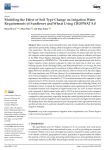Deveci H., Önler B., Erdem T. (2025). Modeling the effect of soil type change on irrigation water requirements of sunflower and wheat using CROPWAT 8.0. Water, 02/05/2025, vol. 17, n. 10, p. 1437.
https://doi.org/10.3390/w17101437
https://doi.org/10.3390/w17101437
| Titre : | Modeling the effect of soil type change on irrigation water requirements of sunflower and wheat using CROPWAT 8.0 (2025) |
| Auteurs : | H. Deveci ; B. Önler ; T. Erdem |
| Type de document : | Article |
| Dans : | Water (vol. 17, n. 10, May 2025) |
| Article en page(s) : | p. 1437 |
| Langues : | Anglais |
| Langues du résumé : | Anglais |
| Catégories : |
Catégories principales 07 - ENVIRONNEMENT ; 7.3 - Eau. Gestion de l'EauThésaurus IAMM BESOIN EN EAU ; EAU D'IRRIGATION ; GESTION DES EAUX ; CEREALICULTURE ; BLE ; HELIANTHUS ANNUUS ; SOL ; TURQUIE |
| Résumé : | Water scarcity, environmental factors, and climate change significantly impact agricultural productivity, making efficient irrigation strategies essential for sustainable crop production. The aim of this study is to determine how different soil types affect the irrigation water requirements of sunflower and wheat. To achieve this aim, the total net irrigation water requirements of sunflower and wheat plants in different soil types in the TR21 Thrace Region (Tekirdag, Edirne, Kirklareli) during the period 1971-2000 was determined by CROPWAT 8.0. The results reveal that light-textured soils lead to higher irrigation water demand compared to other soil types due to their low water-holding capacity. In the Tekirdag, Edirne, and Kirklareli provinces, on average, the total net irrigation water requirement for sunflower in three different soil types was 492.1 mm (light), 457.4 mm (medium), and 437.2 mm (heavy), while for wheat it was 342.5 mm (light), 291.0 mm (medium), and 232.9 mm (heavy). It was determined that sunflower required more total net irrigation water than wheat in all three provinces. Total net irrigation water requirement for sunflower decreased by 7.1% in medium-textured soils compared to light-textured soils, by 11.1% in heavy-textured soils compared to light-textured soils, and by 4.3% in heavy-textured soils compared to medium-textured soils in Tekirdag, Edirne, and Kirklareli provinces. In wheat, the total net irrigation water requirement decreased by 15.0% in medium-textured soils compared to light-textured soils, by 32.0% in heavy-textured soils compared to light-textured soils, and by 20.0% in heavy-textured soils compared to medium-textured soils. Since higher temperatures are observed in Edirne province compared to other provinces, especially during the critical growth periods of sunflower and wheat, the total net irrigation water requirement was found to be higher for both plants. The findings show that climate parameters and soil properties affect agricultural water use, and that soil structure in particular should be taken into consideration when determining irrigation strategies. |
| Cote : | En ligne |
| URL / DOI : | https://doi.org/10.3390/w17101437 |







